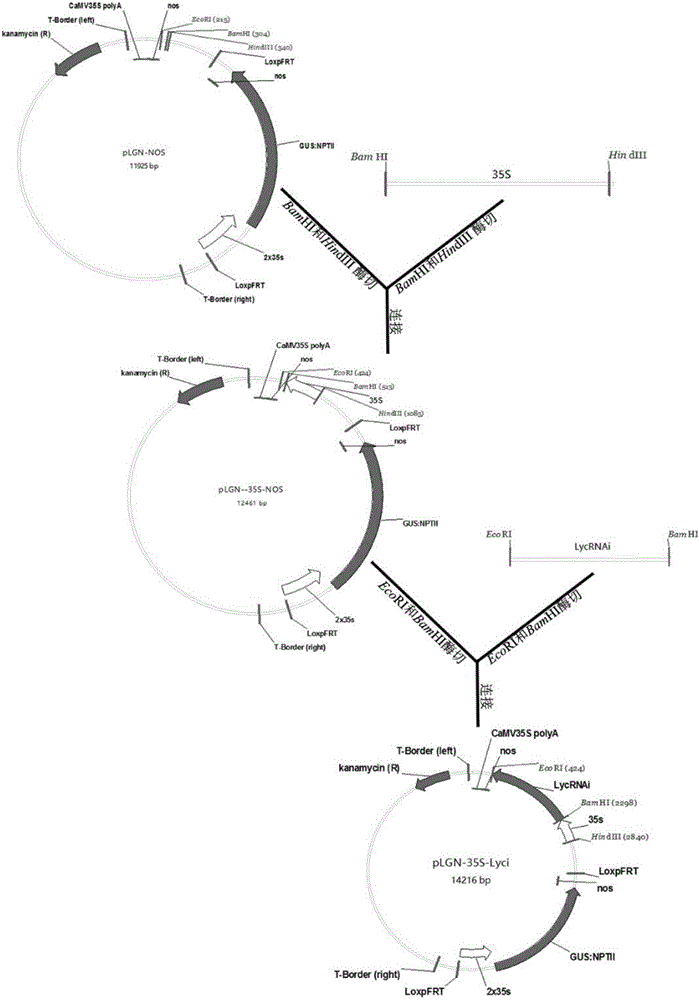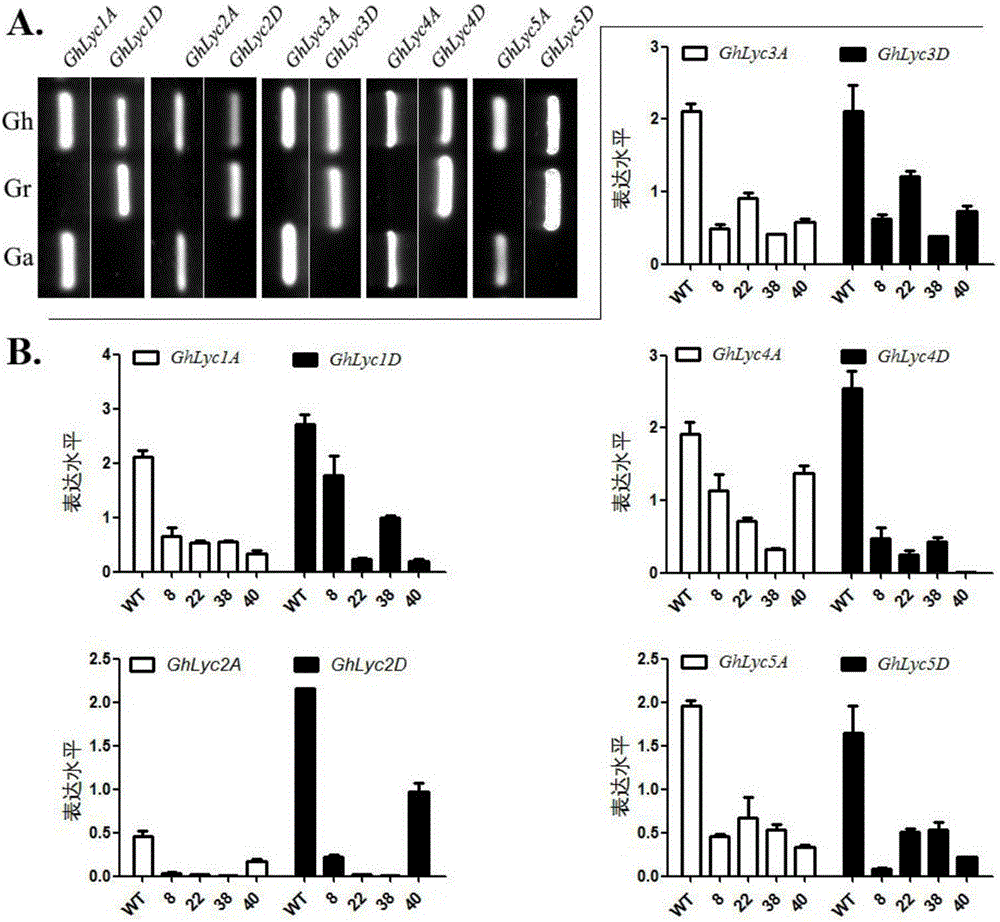Expression vector for comprehensive down-regulation of cotton lycopene cyclase genes and application thereof
A technology of lycopene and plant expression vector, which is applied in the field of plant genetic engineering to achieve the effect of reduced expression level and broad application prospects
- Summary
- Abstract
- Description
- Claims
- Application Information
AI Technical Summary
Problems solved by technology
Method used
Image
Examples
Embodiment 1
[0040] Example 1 Obtaining Silencing Elements
[0041] As mentioned above, upland cotton contains 5 pairs of Lyc genes, and the similarity between the orthologous genes is extremely high (>98%), while the nucleotide sequence similarity of the paralogous genes is low, which is to completely inhibit the Lyc gene in cotton. Gene, we selected a sequence (SEQ ID No.1-5) from each of the five Lyc genes, connected the five sequences in series by asymmetric PCR, and finally formed an inverted repeat sequence containing a spacer sequence, that is, the LycRNAi element ( SEQ ID No. 6). The silencing element can target 5 pairs of 10 Lyc sequences to down-regulate the expression level of lycopene cyclase Lyc gene through RNAi mechanism.
[0042] Firstly, five Lyc1-5 coding sequences and spacer sequences were amplified by using upland cotton genomic DNA as a template (the Lyc2 sequence includes a coding sequence and adjacent intron sequence), and the primers were Lyc1F / R, Lyc2F / R, Lyc2F / R,...
Embodiment 2
[0072] Embodiment 2 Construction of LycRNAi expression vector
[0073] The procedure for constructing LycRNAi elements into the plant expression vector pLGN-nos is shown in figure 2 . The pLGN-nos vector is a binary plant expression vector transformed from the traditional plant expression vector pBI121. Its T-DNA segment (the region between the left and right borders of T-DNA, figure 2 ) was replaced by a constitutive 35S promoter-controlled fusion gene expression cassette of reporter gene GUS and marker gene NptII, and an additional expression cassette controlled by 35S promoter.
[0074] The construction process of LycRNAi vector is as follows: the 35S promoter is excised from the cloning vector with HindⅢ and BamHI, and connected to the pLGN-nos vector digested with HindⅢ and BamHI to construct the pLGN-35S vector. Further, the LycRNAi element was excised from the cloning vector with EcoRI and BamHI, and inserted into the corresponding site of the pLGN-35S vector to ob...
Embodiment 3
[0075] Example 3 Genetic Transformation of Cotton
[0076] The genetic transformation of cotton with the above expression vector was carried out by the method mediated by Agrobacterium tumefaciens, and the formulation of the medium used is shown in Table 3. The specific method is as follows: shell the plump cotton seeds of wild-type upland cotton Ji Mian No. 14, place a small amount (about 20 to 40 seeds) of the shelled seeds in a sterilized 100mL triangular flask, and first use 75% alcohol Wash the seeds for 1 minute, pour out the alcohol, then add 0.1% mercury liter to sterilize for about 12 minutes (constantly shake the triangular flask to sterilize), pour out the mercury liter, add sterile water to fully rinse, rinse about 10 times, the last time An appropriate amount of sterile water was left in the triangular flask. Put it on a shaker (30°C, 100rpm), replace the sterile water every 8 hours, wait for the radicle to grow about 1cm (about 36-48h), gently insert the radicle...
PUM
 Login to View More
Login to View More Abstract
Description
Claims
Application Information
 Login to View More
Login to View More - R&D
- Intellectual Property
- Life Sciences
- Materials
- Tech Scout
- Unparalleled Data Quality
- Higher Quality Content
- 60% Fewer Hallucinations
Browse by: Latest US Patents, China's latest patents, Technical Efficacy Thesaurus, Application Domain, Technology Topic, Popular Technical Reports.
© 2025 PatSnap. All rights reserved.Legal|Privacy policy|Modern Slavery Act Transparency Statement|Sitemap|About US| Contact US: help@patsnap.com



